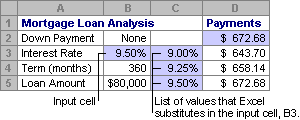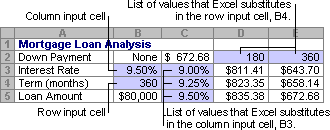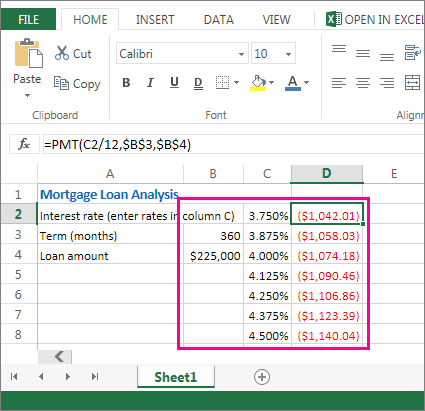How To Find 3 Differnt Values Of X From A Data Set
In Microsoft Excel, data tables are function of a suite of commands known every bit What-If analysis tools. When you lot construct and analyze data tables, y'all are doing what-if analysis.
What-if assay is the process of changing the values in cells to see how those changes volition touch on the outcome of formulas on the worksheet. For example, you can use a data table to vary the interest charge per unit and term length for a loan—to evaluate potential monthly payment amounts.
Types of what-if analysis
In that location are iii types of what-if analysis tools in Excel: scenarios, data tables, and goal-seek. Scenarios and information tables use sets of input values to calculates possible results. Goal-seek is distinctly different, it uses a single result and calculates possible input values that would produce that result.
Like scenarios, information tables assist yous explore a set of possible outcomes. Dissimilar scenarios, data tables show you all the outcomes in one table on one worksheet. Using data tables makes information technology easy to examine a range of possibilities at a glance. Because you focus on simply one or two variables, results are like shooting fish in a barrel to read and share in tabular class.
A data tabular array cannot adapt more than ii variables. If you lot desire to clarify more than ii variables, yous should instead use scenarios. Although it is limited to but ane or two variables (1 for the row input cell and one for the column input cell), a data table tin include as many different variable values as y'all want. A scenario can accept a maximum of 32 different values, only you can create every bit many scenarios equally you desire.
Acquire more than in the article, Introduction to What-If Analysis.
Create either one-variable or two-variable data tables, depending on the number of variables and formulas that you need to test.
1-variable data tables
Use a ane-variable data tabular array if you lot want to see how different values of one variable in ane or more than formulas will alter the results of those formulas. For case, you can use a one-variable data tabular array to see how unlike interest rates affect a monthly mortgage payment by using the PMT function. Y'all enter the variable values in one column or row, and the outcomes are displayed in an adjacent column or row.
In the following analogy, cell D2 contains the payment formula, =PMT(B3/12,B4,-B5), which refers to the input cell B3.

Two-variable data tables
Utilise a ii-variable data table to see how different values of ii variables in one formula volition change the results of that formula. For example, you can use a two-variable information table to meet how unlike combinations of involvement rates and loan terms will affect a monthly mortgage payment.
In the following illustration, cell C2 contains the payment formula, =PMT(B3/12,B4,-B5), which uses ii input cells, B3 and B4.

Data tabular array calculations
Whenever a worksheet recalculates, whatsoever data tables will also recalculate—even if there has been no modify to the information. To speed up calculation of a worksheet that contains a data table, you can change the Calculation options to automatically recalculate the worksheet but not the data tables. To learn more, see the section Speed up calculation in a worksheet that contains data tables.
A one-variable data table incorporate its input values either in a single column (column-oriented), or across a row (row-oriented). Whatsoever formula in a one-variable data table must refer to only ane input cell.
Follow these steps:
-
Type the listing of values that you desire to substitute in the input cell—either downward one column or across one row. Get out a few empty rows and columns on either side of the values.
-
Do one of the following:
-
If the data table is column-oriented (your variable values are in a column), type the formula in the cell one row above and one cell to the right of the column of values. This one-variable data table is cavalcade-oriented, and the formula is contained in cell D2.

If you want to examine the effects of various values on other formulas, enter the additional formulas in cells to the right of the first formula.
-
If the data table is row-oriented (your variable values are in a row), type the formula in the cell ane column to the left of the showtime value and ane cell beneath the row of values.
If you desire to examine the furnishings of various values on other formulas, enter the additional formulas in cells below the showtime formula.
-
-
Select the range of cells that contains the formulas and values that y'all want to substitute. In the figure above, this range is C2:D5.
-
On the Data tab, click What-If Analysis >Data Table (in the Data Tools group or Forecast group of Excel 2016).
-
Do one of the following:
-
If the data tabular array is cavalcade-oriented, enter the prison cell reference for the input cell in the Column input prison cell field. In the figure above, the input cell is B3.
-
If the data table is row-oriented, enter the cell reference for the input cell in the Row input jail cell field.
Notation:After you create your information table, you might want to alter the format of the outcome cells. In the figure, the consequence cells are formatted as currency.
-
Formulas that are used in a ane-variable data table must refer to the same input cell.
Follow these steps
-
Practise either of these:
-
If the data table is cavalcade-oriented, enter the new formula in a bare cell to the correct of an existing formula in the superlative row of the information table.
-
If the information table is row-oriented, enter the new formula in a empty prison cell below an existing formula in the first column of the data table.
-
-
Select the range of cells that contains the data table and the new formula.
-
On the Data tab, click What-If Analysis >Data Table (in the Data Tools group or Forecast group of Excel 2016).
-
Do either of the post-obit:
-
If the information table is column-oriented, enter the jail cell reference for the input cell in the Column input jail cell box.
-
If the data table is row-oriented, enter the cell reference for the input prison cell in the Row input cell box.
-
A two-variable data tabular array uses a formula that contains two lists of input values. The formula must refer to two different input cells.
Follow these steps:
-
In a prison cell on the worksheet, enter the formula that refers to the ii input cells.
In the post-obit example—in which the formula starting values are entered in cells B3, B4, and B5, you lot type the formula =PMT(B3/12,B4,-B5) in jail cell C2.
-
Type i list of input values in the same column, below the formula.
In this case, type the dissimilar involvement rates in cells C3, C4, and C5.
-
Enter the 2d list in the same row every bit the formula—to its right.
Type the loan terms (in months) in cells D2 and E2.
-
Select the range of cells that contains the formula (C2), both the row and column of values (C3:C5 and D2:E2), and the cells in which you want the calculated values (D3:E5).
In this case, select the range C2:E5.
-
On the Data tab, in the Data Tools group or Forecast group (in Excel 2016), click What-If Analysis >Data Tabular array (in the Information Tools grouping or Forecast group of Excel 2016).
-
In the Row input cell field, enter the reference to the input cell for the input values in the row.
Type prison cell B4 in the Row input prison cell box. -
In the Cavalcade input jail cell field, enter the reference to the input cell for the input values in the cavalcade.
Blazon B3 in the Column input cell box. -
Click OK.
Case of a two-variable information table
A two-variable data table can bear witness how different combinations of interest rates and loan terms volition affect a monthly mortgage payment. In the figure here, cell C2 contains the payment formula, =PMT(B3/12,B4,-B5), which uses two input cells, B3 and B4.

When you lot gear up this adding option, no data-table calculations occur when a recalculation is washed on the entire workbook. To manually recalculate your data table, select its formulas and then press F9.
Follow these steps to better calculation performance:
-
Click File > Options > Formulas.
-
In the Calculation options department, nether Calculate, click Automatic except for data tables.
Tip:Optionally, on the Formulas tab, click the arrow on Calculation Options, then click Automatic Except Information Tables (in the Adding group).
Y'all tin use a few other Excel tools to perform what-if analysis if you lot accept specific goals or larger sets of variable data.
Goal Seek
If you know the outcome to expect from a formula, just don't know precisely what input value the formula needs to go that effect, use the Goal-Seek feature. See the article Utilize Goal Seek to discover the upshot you desire by adjusting an input value.
Excel Solver
Yous can employ the Excel Solver add-in to find the optimal value for a set of input variables. Solver works with a group of cells (chosen decision variables, or simply variable cells) that are used in computing the formulas in the objective and constraint cells. Solver adjusts the values in the decision variable cells to satisfy the limits on constraint cells and produce the result yous want for the objective prison cell. Learn more than in this commodity: Define and solve a trouble by using Solver.
By plugging dissimilar numbers into a cell, you can quickly come up with different answers to a problem. A swell case is using the PMT role with different interest rates and loan periods (in months) to figure out how much of a loan you can beget for a habitation or a motorcar. You enter your numbers into a range of cells called a data table.
Here, the data table is the range of cells B2:D8. Y'all can alter the value in B4, the loan corporeality, and the monthly payments in column D automatically update. Using a 3.75% involvement rate, D2 returns a monthly payment of $i,042.01 using this formula: =PMT(C2/12,$B$iii,$B$4).

You can use ane or two variables, depending on the number of variables and formulas you want to test.
Use a i-variable examination to see how dissimilar values of one variable in a formula will change the results. For example, you can alter the interest rate for a monthly mortgage payment by using the PMT office. Y'all enter the variable values (the interest rates) in one column or row, and the outcomes are displayed in a nearby cavalcade or row.
In this alive workbook, jail cell D2 contains the payment formula =PMT(C2/12,$B$3,$B$iv). Cell B3 is the variable cell, where you can plug in a dissimilar term length (number of monthly payment periods). In cell D2, the PMT part plugs in the interest charge per unit iii.75%/12, 360 months, and a $225,000 loan, and calculates a $1,042.01 monthly payment.
Utilise a two-variable exam to see how different values of two variables in a formula will alter the results. For example, you can examination different combinations of involvement rates and number of monthly payment periods to calculate a mortgage payment.
In this live workbook, cell C3 contains the payment formula, =PMT($B$three/12,$B$2,B4), which uses two variable cells, B2 and B3. In prison cell C2, the PMT function plugs in the involvement rate 3.875%/12, 360 months, and a $225,000 loan, and calculates a $1,058.03 monthly payment.
How To Find 3 Differnt Values Of X From A Data Set,
Source: https://support.microsoft.com/en-us/office/calculate-multiple-results-by-using-a-data-table-e95e2487-6ca6-4413-ad12-77542a5ea50b
Posted by: monarrezyousses.blogspot.com


0 Response to "How To Find 3 Differnt Values Of X From A Data Set"
Post a Comment